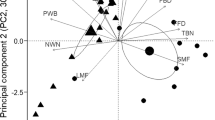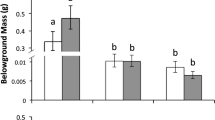Abstract
Reproductive traits are tightly linked to plant fitness and may therefore be mechanisms driving biological invasions, including the greater success of more phylogenetically novel introduced species in some systems. We present a phylogenetic comparative analysis of “Baker’s law’’, that introduced plants with the ability to reproduce autogamous or asexually may be better able to establish on introduction. We gathered data from both published and unpublished sources on pollen limitation of 141 species, including 26 introduced species and 115 native species. Our analysis compared differences in the proportion of autonomous autogamy, asexual reproduction, and pollen limitation among native, introduced noninvasive, and introduced invasive plant species, and included the phylogenetic novelty of the introduced species to the native species in that community. Introduced species were more likely to be autogamous than native species, consistent with Baker’s law. On the other hand, introduced species were less likely to have the ability to reproduce asexually. Further, among species with no autonomous autogamy, pollen limitation was greater for introduced compared to native species. Such a result is consistent with the idea that plants entering a new continent receive lower quality or quantity of services from resident pollinators than species native to that continent. Finally, more phylogenetically novel invasive species had lower pollen limitation than less novel invasive species, potentially because they experience less competition for pollinators. This is the first evidence that enhanced pollination may be one mechanism driving the greater invasiveness of phylogenetically novel introduced species observed in some systems.




Similar content being viewed by others
References
Ackerly DD (2000) Taxon sampling, correlated evolution, and independent contrasts. Evolution 54:1480–1492. doi:10.1111/j.0014-3820.2000.tb00694.x
Baker HG (1955) Self-compatibility and establishment after ‘long-distance’ dispersal. Evolution 9:347–349. doi:10.2307/2405656
Baker HG (1974) The evolution of weeds. Annu Rev Ecol Evol Syst 5:1–24. doi:10.1146/annurev.es.05.110174.000245
Blomberg SP, Garland TJ, Ives AR (2003) Testing for phylogenetic signal in comparative data: behavioral traits are more labile. Evolution 57:717–745. doi:10.1111/j.0014-3820.2003.tb00285.x
Brown BJ, Mitchell RJ, Graham SA (2002) Competition for pollination between an invasive species (purple loosestrife) and a native congener. Ecology 83:2328–2336. doi:10.1890/0012-9658(2002)083[2328:CFPBAI]2.0.CO;2
Burnham KP, Anderson DR (2002) Model selection and inference: a practical information-theoretic approach. Springer, New York
Cadotte MW, Hamilton MA, Murray BR (2009) Phylogenetic relatedness and plant invader success across two spatial scales. Divers Distrib 15:481–488. doi:10.1111/j.1472-4642.2009.00560.x
Cahill JF, Kembel SW, Lamb EG, Keddy PA (2008) Does phylogenetic relatedness influence the strength of competition among vascular plants? Perspect Plant Ecol. Evol Syst 10:41–50. doi:10.1016/j.ppees.2007.10.001
Cappuccino N, Carpenter D (2005) Invasive exotic plants suffer less herbivory than non-invasive exotic plants. Biol Lett 1:435–438. doi:10.1098/rsbl.2005.0341
Colautti RI, Ricciardi A, Grigorovich IA, MacIsaac HJ (2004) Is invasion success explained by the enemy release hypothesis? Ecol Lett 7:721–733. doi:10.1111/j.1461-0248.2004.00616.x
Daehler CC (2001) Darwin’s naturalization hypothesis revisited. Am Nat 158:324–330. doi:10.1086/324116
Darwin C (1859) On the origin of species by means of natural selection, or the preservation of favoured races in the struggle for life, 1st edn. John Murray, London
De Candolle AP (1855) Géographie Botanique Raisonné, vol 2. V. Masson, Paris
Dodd ME, Silvertown J, Chase MW (1999) Phylogenetic analysis of trait evolution and species diversity variation among angiosperm families. Evolution 53:732–744
Duncan RP, Williams PA (2002) Darwin’s naturalization hypothesis challenged. Nature 417:608. doi:10.1038/417608a
Felsenstein J (1985) Phylogenies and the comparative method. Am Nat 125:1–15. doi:10.1086/284325
Fishman L, Wyatt R (1999) Pollinator-mediated competition, reproductive character displacement, and the evolution of selfing in Arenaria uniflora (Caryophyllaceae). Evolution 53:1723–1733
GCW [Global Compendium of weeds] (2007) Global compendium of weeds. [WWW document]. http://www.hear.org/gcw/index.html
González-Díaz N, Ackerman JD (1988) Pollination, fruit set, and seed production in the orchid Oeceoclades maculata. Lindleyana 3:150–155
Goodwillie C, Kalisz S, Eckert CG (2005) The evolutionary enigma of mixed mating systems in plants: occurrence, theoretical explanations, and empirical evidence. Annu Rev Ecol Evol Syst 36:47–79. doi:10.1146/annurev.ecolsys.36.091704.175539
Harmon-Threatt AN, Burns JH, Shemyakina LA, Knight TM (2009) Breeding system and pollination ecology of introduced plants compared to their native relatives. Am J Bot 96:1544–1550. doi:10.3732/ajb.0800369
Hedges LV, Gurevitch J, Curtis PS (1999) The meta-analysis of response ratios in experimental ecology. Ecology 80:1150–1156. doi:10.2307/177062
Hill SB, Kotanen PM (2009) Evidence that phylogenetically novel non-indigenous plants experience less herbivory. Oecologia 161:581–590. doi:10.1007/s00442-009-1403-0
Keane R, Crawley MJ (2002) Exotic plant invasions and the enemy release hypothesis. Trends Ecol Evol 17:164–170. doi:10.1016/S0169-5347(02)02499-0
Kelly CK, Woodward FI (1996) Ecological correlates of plant range size: taxonomies and phylogenies in the study of plant commonness and rarity in Great Britain. Philos Trans R Soc Lond B 351:1261–1269. doi:10.1098/rstb.1996.0109
Knight TM, Steets J, Vamosi A, Mazer SJ, Burd M, Campbell DR, Dudash MR, Johnston MO, Mitchell RJ, Ashman T-L (2005) Pollen limitation of plant reproduction: pattern and process. Annu Rev Ecol Evol Syst 36:467–497. doi:10.1146/annurev.ecolsys.36.102403.115320
Knight TM, Steets JA, Ashman T-L (2006) A quantitative synthesis of pollen supplementation experiments highlights the contribution of resource reallocation to estimates of pollen limitation. Am J Bot 93:271–277. doi:10.3732/ajb.93.2.271
Lambdon PW, Hulme PE (2006) How strongly do interactions with closely-related native species influence plant invasions? Darwin’s naturalization hypothesis assessed on Mediterranean islands. J Biogeogr 33:1116–1125. doi:10.1111/j.1365-2699.2006.01486.x
Lockwood JL, Simberloff D, McKinney ML, Von Holle B (2001) How many, and which, plants will invade natural areas. Biol Invasions 3:1–8. doi:10.1023/A:1011412820174
Mack RN (1996) Predicting the identity and fate of plant invaders: emergent and emerging approaches. Biol Conserv 78:107–121. doi:10.1016/0006-3207(96)00021-3
Maddison WP (2000) Testing character correlation using pairwise comparisons on a phylogeny. J Theor Biol 202:195–204. doi:10.1006/jtbi.1999.1050
Maddison WP (2006) Pairwise comparisons package for Mesquite, version 1.1. http://mesquiteproject.org
Maddison WP, Maddison DR (2009) Mesquite: a modular system for evolutionary analysis. Version 2.6. http://mesquiteproject.org
Martins EP, Hansen TF (1997) Phylogenies and the comparative method: a general approach to incorporating phylogenetic information into the analysis of interspecific data. Am Nat 149:646–667. doi:10.1080/10635150290155863
Memmott J, Waser NM (2002) Integration of alien plants into a native flower-pollinator visitation web. Proc R Soc Lond B 269:2395–2399. doi:10.1098/rspb.2002.2174
Moeller DA (2004) Facilitative interactions among plants via shared pollinators. Ecology 85:3289–3301. doi:10.1890/03-0810
Moeller DA, Geber MA (2005) Ecological context of the evolution of self-pollination in Clarkia xantiana: population size, plant communities, and reproductive assurance. Evolution 59:786–799. doi:10.1554/04-656
Morales CL, Traveset A (2008) Interspecific pollen transfer: magnitude, prevalence and consequences for plant fitness. Crit Rev Plant Sci 27:221–238. doi:10.1080/07352680802205631
Paradis E (2006) Analyses of phylogenetics and evolution with R. Springer, New York
Pearse IS, Hipp AL (2009) Phylogenetic and trait similarity to a native species predict herbivory on non-native oaks. Proc Natl Acad Sci USA 106:18097–18102. doi:10.1073/pnas.0904867106
Powell KI, Krakos KN, Knight TM (2010) Comparing the reproductive success and pollination biology of an invasive plant to its rare and common native congeners: a case study in the genus Cirsium (Asteraceae). Biol Invasions doi:10.1007/s10530-010-9878-5
Purvis A, Garland T Jr (1993) Polytomies in comparative analyses of continuous characters. Syst Biol 42:569–575. doi:10.2307/2992489
R Statistics, R Development Core Team (2010) R: a language and environment for statistical computing. R Foundation for Statistical Computing, Vienna. <http://www.R-project.org>
Rambuda TD, Johnson SD (2004) Breeding systems of invasive alien plants in South Africa: does Baker’s rule apply? Divers Distrib 10:409–416. doi:10.1111/j.1366-9516.2004.00100.x
Reichard SH, Hamilton CW (1997) Predicting invasions of woody plants introduced into North America. Conserv Biol 11:193–203. doi:10.1078/1433-8319-00004
Rejmánek M (1996) A theory of seed plant invasiveness: the first sketch. Biol Conserv 78:171–181. doi:10.1016/0006-3207(96)00026-2
Rezende EL, Lavabre JE, Guimaraes PR Jr, Jordano P, Bascompte J (2007) Non-random coextinctions in phylogenetically structured mutualist networks. Nature 448:925–928. doi:10.1038/nature05956
Ricciardi A, Atkinson SK (2004) Distinctiveness magnifies the impact of biological invaders in aquatic ecosystems. Ecol Lett 7:781–784. doi:10.1111/j.1461-0248.2004.00642.x
Ricciardi A, Mottiar M (2006) Does Darwin’s naturalization hypothesis explain fish invasions? Biol Invasions 8:1403–1407. doi:10.1007/s10530-006-0005-6
Richardson DM, Allsopp N, D’Antonio CM, Milton SJ, Rejmánek M (2000) Plant invasions—the role of mutualisms. Biol Rev 75:65–93. doi:10.1111/j.1469-185X.1999.tb00041.x
Sargent RD, Ackerly DD (2008) Plant-pollinator interactions and the assembly of plant communities. Trends Ecol Evol 23:123–130. doi:10.1016/j.tree.2007.11.003
Stevens PF (2009) Angiosperm phylogeny website. Version 9, June 2008. http://www.mobot.org/MOBOT/research/APweb/. Accessed 21 April 2009
Strauss SY, Webb CO, Salamin N (2006) Exotic taxa less related to native species are more invasive. Proc Natl Acad Sci USA 103:5841–5845. doi:10.1073/pnas.0508073103
Sutherland S (2004) What makes a weed a weed: life history traits of native and exotic plants in the USA. Oecologia 141:24–39. doi:10.1007/s00442-004-1628-x
Swofford DL (1998) PAUP* Phylogenetic analysis using parsimony (and other methods), V. 4.0 beta 10. Sinauer, Sunderland
Tyson Flora (2008) Tyson flora. [WWW document]. URL http://www.biology.wustl.edu/tyson/flora.html
USDA (2007) USDA Plants Database. [WWW document]. URL http://plants.usda.gov
van Kleunen M, Manning JC, Pasqualetto V, Johnson SD (2008) Phylogenetically independent associations between autonomous self-fertilization and plant invasiveness. Am Nat 171:195–201. doi:10.1086/525057
Verhoeven KJF, Biere A, Harvey JA, van der Putten WH (2009) Plant invaders and their novel natural enemies: who is naive? Ecol Lett 12:107–117. doi:10.1111/j.1461-0248.2008.01248.x
Webb CO, Donoghue MJ (2005) Phylomatic: tree assembly for applied phylogenetics. Mol Ecol Notes 5:181–183. doi:10.1111/j.1471-8286.2004.00829.x
Webb CO, Ackerly DD, McPeek MA, Donoghue MJ (2002) Phylogenies and community ecology. Annu Rev Ecol Syst 33:475–505. doi:10.1146/annurev.ecolsys.33.010802.150448
Wikström N, Savolainen V, Chase MW (2001) Evolution of angiosperms: calibrating the family tree. Proc R Soc Lond B 268:2211–2220. doi:10.1098/rspb.2001.1782
Acknowledgments
We thank LA Shemyakina, KI Powell, AC Blair and LM Wolfe for sharing unpublished pollen limitation data with us. J. Walker provided access to a population of Lonicera flava. T. Mohrman provided significant help with species location and identification. I.M. Parker suggested that more novel species could be more likely to be intentionally introduced species, with larger flowers. K.S. Moriuchi, M. Fishbein, S.A. Price and S.Y. Strauss provided valuable comments on the manuscript. This project was funded by the National Research Initiative of the United States Department of Agriculture Cooperative State Research, Education and Extension Service, grant number #05–2290, Tyson Research Center, Washington University in St. Louis, and the American Association of University Women. Experiments here comply with the laws and regulations in Missouri, USA.
Author information
Authors and Affiliations
Corresponding author
Additional information
Communicated by Alice Winn.
Electronic supplementary material
Below is the link to the electronic supplementary material.
Rights and permissions
About this article
Cite this article
Burns, J.H., Ashman, TL., Steets, J.A. et al. A phylogenetically controlled analysis of the roles of reproductive traits in plant invasions. Oecologia 166, 1009–1017 (2011). https://doi.org/10.1007/s00442-011-1929-9
Received:
Accepted:
Published:
Issue Date:
DOI: https://doi.org/10.1007/s00442-011-1929-9




